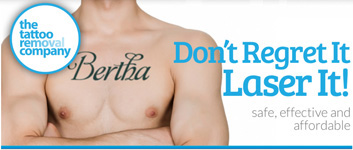ANPR - Automatic Number Plate Recognition

Automatic Number Plate Recognition (ANPR)
is probably the next growth product to take off in the UK, (and
the world)
Automatic Number Plate Recognition or ANPR is
a technology that uses pattern recognition to 'read' vehicle
number plates. In simple terms ANPR cameras 'photograph' the
number plates of the vehicles that pass them. This 'photograph'
is then fed in a computer system to find out details about the
driver and owner of the vehicle and details about the vehicle
itself.
How does ANPR work?
ANPR 'reads' Vehicle Registration Marks - more
commonly known as number plates - from digital images, captured
through cameras located either in a mobile unit, in-built in
traffic vehicles or via Closed Circuit Television (CCTV).
The cameras can check up to 3,600 number plates
an hour on cars travelling in excess of 100mph. There are a
number of different systems available.
These can be categorised into four types:
In-car devices, seen that device
on the roof of some police cars that looks like a spotlight
on the back, it is an ANPR unit. Some can be seen behind the
glass of the rear window as well. The can do checks as you overtake
them.
Transportable (e.g. mobile units that can be
set up at the roadside)
CCTV (that ‘piggy-back’ on existing
systems)
Fixed gantry systems that continuously monitor
a stretch of road (e.g. in ports, City of London)
The digital image is converted into data, which
is processed through the ANPR system. This system is able to
cross reference the data against a variety of databases including
the Police National Computer (PNC), Local Force Intelligence
Systems and other related databases, for example DVLA
Once the data has been cross checked against
these databases - a process that takes around 1.5 seconds to
complete - information about the vehicle, its registered owner
and driver appears on a computer where it is evaluated by ANPR
officers.
If the information supplied via the ANPR system
alerts officers to an offence or relevant intelligence on a
vehicle, the vehicle will be stopped to allow officers to investigate
further. ANPR officers acting as 'interceptors' also use their
observation to stop other offenders not highlighted by the system.
ANPR systems are able to check up to 3,000 number plates per
hour, per lane, even at speeds of up to 100mph.
The ANPR mobile unit should be easily distinguishable
from the safety camera mobile units.
ANPR cameras are NOT safety cameras -
i.e. they are not in place to catch speeding motorists.
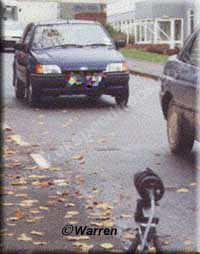 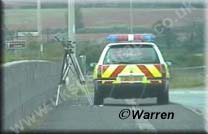 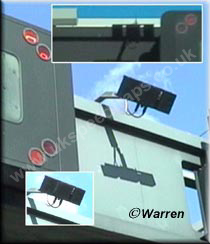
Left: Simple Roadside
ANPR unit Middle: Twin ANPR system, in use on
A38 Right: M25 units
The City of London Police are using
Number Plate Recognition Systems on their check points, at the
entry points to the city, one just off London Bridge, another
near Liverpool Street railway station. These form a part of their
anti-terrorist precautions as part of the so-called 'Ring Of Steel'
At times of tension, the check points are sometimes manned. As
you enter one point of the city you can see one such system mounted
on a phone box, providing a live link via ISDN to the HQ.
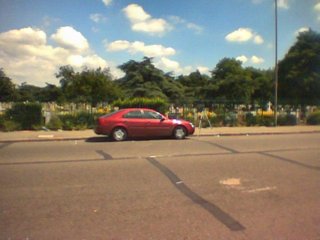
Some major routes have had systems
fitted, and can be seen on overhead gantries
The white van...you may have seen the press, mainly in the Sun Newspaper.
They reported a white van in use in Birmingham that was used to
nick speeders using two cameras pointing out the back windows...
as usual the Sun jumped the gun and got it wrong.. The van is
used to read number plates and then see if the car is nicked or
not known and so on. If the vehicle is flagged up then further
down the road they will pull you over. Its not a speedtrap...
yet.
 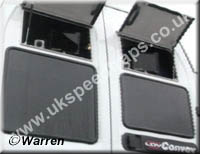
Above: The Van
in question, top flaps open to reveal the cameras.
ANPR... extra notes, I found
this while I was surfing.... Her Majesty's Inspector is concerned
over the inherent risks associated with automatic number plate
recognition systems (ANPR) which then feed off the PNC vehicle
database. This adds police information to a copy of the DVLA database
which is maintained primarily for vehicle registration and tracking
excise duty (road tax).
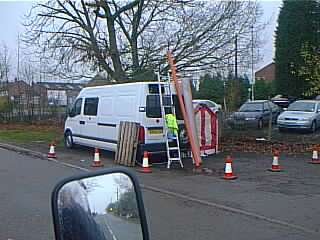
The DVLA are reliant upon keepers
and police for the accuracy of data and their estimates are that
up to one million records might contain errors. Additionally,
records are up to six weeks out of date due to the time taken
for owners to notify DVLA of changes. Similarly, the police information
on the PNC database is not always updated when it should be and
thus contains errors.
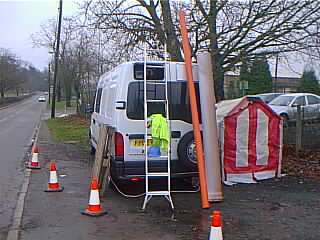
To use an historic and inaccurate
database for increasing numbers of real-time functions runs the
risk of unnecessary stops by police and, inevitably, wrongful
arrest. Her Majesty's Inspector strongly urges those managing
ANPR systems to ensure all staff using the data are fully aware
of its limitations; as detailed in the recent ACPO Policy and
Guidelines for ANPR systems.
Police use petrol station 'spies'
Drivers using petrol stations will have
their number plates read and checked against the police database
in a new scheme being launched.
West Yorkshire Police say it is the first time in
Britain forecourts have been used to install Automatic Number
Plate Recognition systems which have a direct link to the police
computer.
A number of service stations in the Bradford area
have been fitted with the ANPR technology.
The registration number of every vehicle will be
read as it enters the forecourt and will then be compared with
a comprehensive database of vehicles linked to criminal activity
on the West Yorkshire Police computer systems.
If there is a match, police will be alerted immediately.
Chief Supt Geoff Dodd said: "The forecourt
scheme is primarily a crime reduction tool designed to reduce
forecourt crime and in particular drivers making off without payment.
"The knock-on effect is that it will also help
in the detection of such crimes and be a valuable source of intelligence
to the police.
Mr Dodd said all 53 service stations in the Bradford
area have been invited to join the scheme.
Pc Mick Warburton, Bradford District Forecourt Crime
Officer, said: "During trials that have been held the sites
have been averaging six alerts a day from the police database.
This means that potentially six drive-offs a day are being prevented.
"The results are very encouraging and all indications
are that the system will lead to a vast reduction in crime."
|



